
Made for the shade, hostas are a mainstay for woodland gardens across much of the country. More than 40 species (most native to Japan) and their numerous cultivars and hybrids offer a continuum of size from thumbnail small to almost umbrella; hues from apple green to dark spruce, sunny yellow and glaucous blue; a diversity of variegations with white or golden edges or centers; and leaf shapes from long and narrow to wide and heart shaped. Attractive spikes of purple or white bell-like flowers, sometimes fragrant, add the crowning touch to this variable genus.
Swipe to view slides
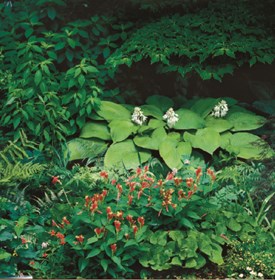
Photo by: J. Paul Moore.
1. ‘GOLDEN SCULPTURE’
A large, suntolerant hosta, with smooth, pale golden-ellow leaves accented with widely spaced veins. In the summer it produces white flowers on 3-foot-tall stems. At maturity it makes a substantial 2-foot-tall mound of foliage.
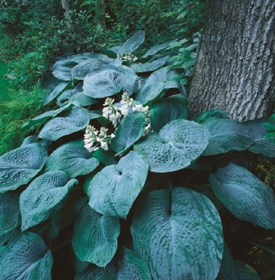
Photo by: J. Paul Moore.
2. HOSTA SIEBOLDIANA VAR. ELEGANA
Deservedly popular, with large grayish blue, waxy leaves. Forms a clump 3 feet tall and 4 to 5 feet wide. Pale lilac to white flowers. Site carefully, as its cupped leaves and heavily puckered surface make it a catchall for debris from trees and shrubs.
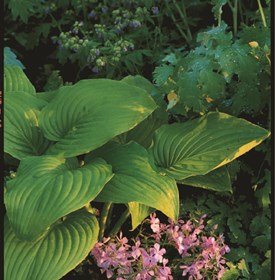
Photo by: J. Paul Moore.
3. HOSTA PLANTAGINEA
Called August lily for the sweet fragrance of its waxy white flowers in late summer. Leaves in Granny Smith apple green allow it to thrive in shade, but it is also sun-tolerant. Forms a mound 2 feet by 2 feet.
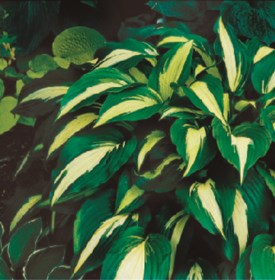
Photo by: J. Paul Moore.
4. ‘NIGHT BEFORE CHRISTMAS’
Clumps 18 inches tall and 30 inches wide have a crisp appearance, with lavender flowers on 30-inch stalks. Medium green leaves are ruffled along the margins and narrow to a point, accentuated by a clean, white central stripe.
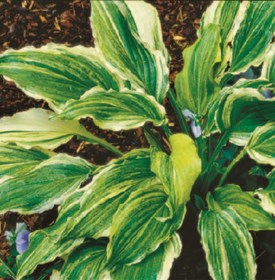
Photo by: J. Paul Moore.
5. ‘GINSU KNIFE’
Only 14 inches tall, it more than makes up for its lack of stature with showy foliage, its narrow leaves brandishing irregular, streaky, creamy yellow margins. White flowers in summertime are fragrant.
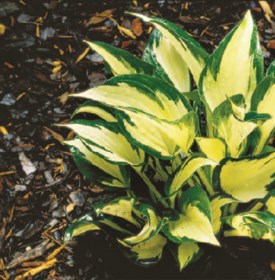
Photo by: J. Paul Moore.
6. ‘FIRE AND ICE’
A hosta with panache: heavy leaves with good substance, somewhat curled and twisted, embellished by a broad, irregular cream white blotch and a dark green margin. Forms mounds 12 inches wide by 8 inches high, with pale lavender flowers.
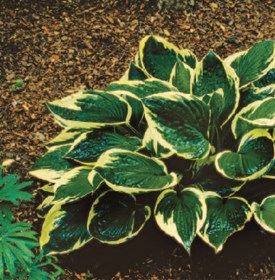
Photo by: J. Paul Moore.
7. ‘MINUTEMAN’
Often confused with ‘Patriot’. Both have irregular, wide white margins on dark green leaves. Seen side by side, ‘Minuteman’ is darker green and has more substance. Makes a dense clump 3 feet wide and 2 feet high, with lavender flowers in early summer.
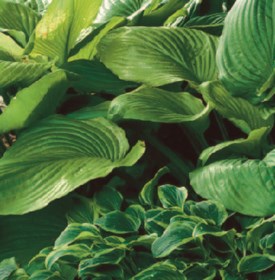
Photo by: J. Paul Moore.
8. ‘SUM AND SUBSTANCE’
A bold specimen in any garden. An award-winning, sun-tolerant, oversize hosta making a mound up to 5 feet across when mature. Leaf color depends on how much sun it receives—golden with more light, chartreuse with less. Pale lavender flowers.
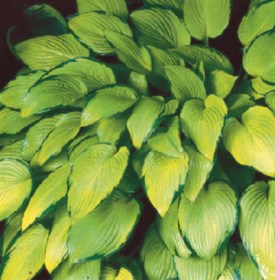
Photo by: J. Paul Moore.
9. ‘GOLD STANDARD’
Quick-growing, robust hosta. Leaves unfold chartreuse green with dark green edging, becoming more golden with good light. But full sun damages the leaves, which lose texture, becoming papery and whitish. Forms a substantial mound 36 inches wide and 20 inches tall, with lavender flowers.
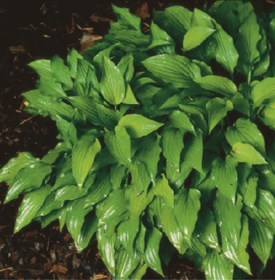
Photo by: J. Paul Moore.
10. ‘GINGEE’
Golden hosta of modest proportions, with narrow, inch-wide leaves about 8 inches long, giving it an almost sedgelike appearance. Growing about 12 inches high and wide, in summer purple-striped flowers on 18-inch stems make a strong contrast.
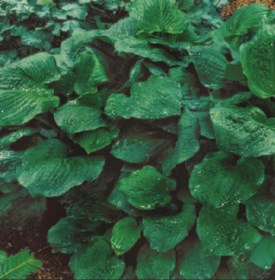
Photo by: J. Paul Moore.
11. ‘BLACK BEAUTY’
Very dark, forest-green leaves are wonderfully accented with deep veining. Making a mound 4 feet across by 2 feet tall, it creates a statuesque focal point in the shady garden, adorned with lavender flowers in summer.
Hosta Basics
Appeal: Call it funkia or plantain lily—the name may have changed over the years, but the popularity of the plant now called hosta remains unchanged. The antithesis of fussy, hostas are attractive, easy-to-please plants providing garden interest from spring to fall. Their diversity of size inspires a variety of uses, from striking specimen or focal point to edging or ground cover. Hostas contribute the all-important element of texture to a garden, and a collection with varying foliage colors and shapes is visually interesting even without flowers.
Zones: Hostas thrive from cold-hardiness Zones 8 or 9, where frost is mild and does not linger, to chilly Zone 3.
Exposure: Dappled to partial shade is preferable, though they will tolerate moderately heavy shade. Hostas with more substantial foliage will accept full sun in cooler zones, provided they are given ample and constant moisture.
Soil: Hostas grown in a good loamy soil enriched with organic matter such as compost produce the most luxuriant foliage. Even levels of moisture are preferred, and mulch helps reduce fluctuations. Avoid dry conditions.
Care: Spring, as new shoots appear, is the best time to plant hostas or divide and transplant established clumps. It often takes four to five years for hostas to mature and division is usually not necessary before this time. Deer devour hostas; regular use of different repellents can help, or install deer fencing. Deter slugs and snails by using diatomaceous earth or slug bait; the best preventive maintenance is the removal of weeds and decaying leaves around hostas to keep the area clean.
Designing with Hostas
- Bold-leaved hostas provide contrast to lacy plants such as ferns and astilbe or linear foliage such as sedges or liriope. Keep things in proportion—supersized ‘Sum and Substance’ will overshadow a small fern.
- Pair hostas with summer-dormant plants such as Virginia bluebells (Mertensia virginica). The hostas continue to provide interest after the bluebells have died back.
- Hosta leaves are great additions to a bouquet or foliage arrangements. Use larger hosta leaves as placemats for alfresco meals.
- Hostas with white-variegated leaves or white flowers make great additions to a moonlight garden.